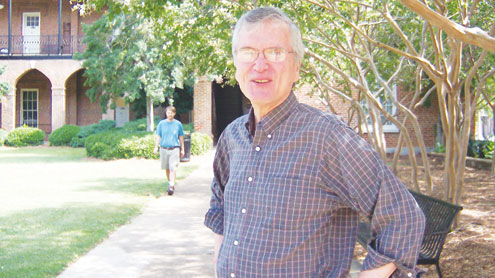Art history professor Robert Mellown is set to retire at the end of the spring semester after decades of teaching at the University. The 2011-2012 academic year marks his fortieth in the department of art and art history, and, according to Mellown, 40 is enough.
“It was about time to retire, and it seemed like a good idea to end it on a nice round number like 40,” he said with a laugh. “I’ve spent almost two-thirds of my life teaching art history.”
After completing his undergraduate degree at UA and doctoral studies at the University of North Carolina-Chapel Hill, Mellown returned to the University to teach 19th-century art and architecture, ancient art and Renaissance art and has done so ever since.
Mellown said he wouldn’t have had it any other way.
“To teach effectively, you’ve really got to like your subject, and I do. I love art, and I love teaching it,” he said. “Also, to teach effectively you have to keep up with your research, so you’re always learning something new.”
Mellown doesn’t keep the love all to himself — his enthusiasm for teaching and learning rubs off on his students.
“He’s so knowledgeable, organized and caring, so that makes him a great teacher, and the kids really pick up on that,” said Cathy Pagani, art history professor and department chair who has known Mellown for 19 years. “This year for registration, I had students coming to me and saying, ‘I hear this is Dr. Mellown’s last year here, and I need an override because I have to get into his class before he’s gone.’ That was really touching.”
Throughout his time at the University, Mellown’s passion for research and learning has consistently extended far beyond the walls of the classroom. From his authorship of the 1988 book, “The University of Alabama: A Guide to the Campus,” and years of contribution to Alabama Heritage Magazine to his recreational research of Tuscaloosa and Alabama genealogy and architecture, Mellown’s studies have made him a multi-faceted authority on Tuscaloosa and University history.
“He has such a unique perspective on the University that very few people have. For instance, he’s shown me places where there is graffiti from students who were here in the 1870s — and he is able to identify who they were,” said Rachel Dobson, communications specialist and visual resources curator for the department and a long-time friend of Mellown. “He knows so many things about the University, about what’s going on in context of what’s happening now and what has happened in the past.”
As if all of this teaching and research wasn’t enough, Mellown has also been called upon several times to write structural reports for several fixtures in Tuscaloosa history, including the John R. Drish House and Bryce Hospital.
“The [Bryce Hospital] report was not just writing about the building, it was investigating the entire structure,” Mellown said. “I think I’m the only person who’s spent days up there crawling around in the attics of this mental institution. That report was big — it ended up being about 300 to 400 pages.”
Four decades have provided ample time for change — in technology and the student body, to name just two sectors — and Mellown has experienced it all. During his time on campus, he has seen literally thousands of students move through the University.
“I was just thinking the other day, we used to spend two full days at the beginning of every semester for class registration,” he said. “Everybody would line up outside of Coleman and register. If you were one of the faculty down on the floor, you would see every single student at the University come through. You don’t have that kind of situation anymore, where every single student is in the same place.”
Though he is retiring in a month, Mellown has no plans to leave the place with which he has been so involved for so long. He is currently putting the finishing touches on another updated publication about campus architecture, and he hopes to continue teaching one course a semester if the department has a place for him.
“I’m looking forward to having more time for my research work, but it’s hard to imagine not teaching,” he said. “It’s really been enjoyable mixing teaching with all these other learning experiences, and the University has been a perfect place to do it.”









